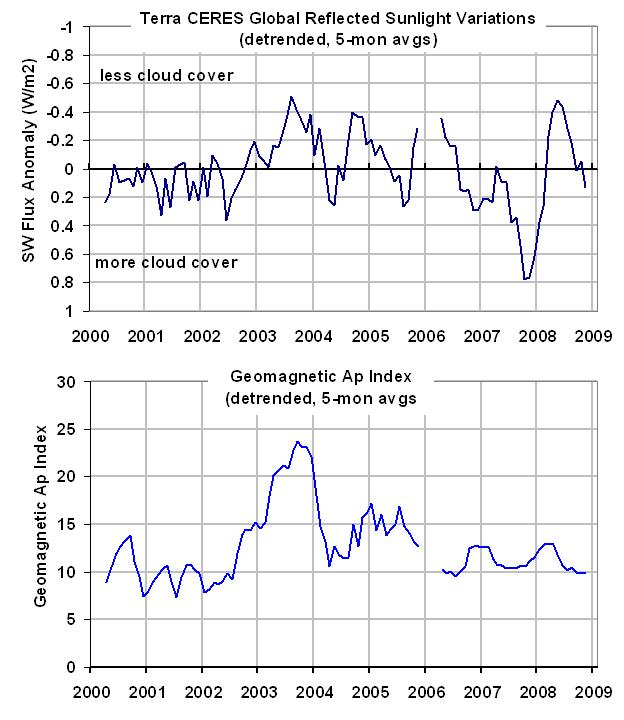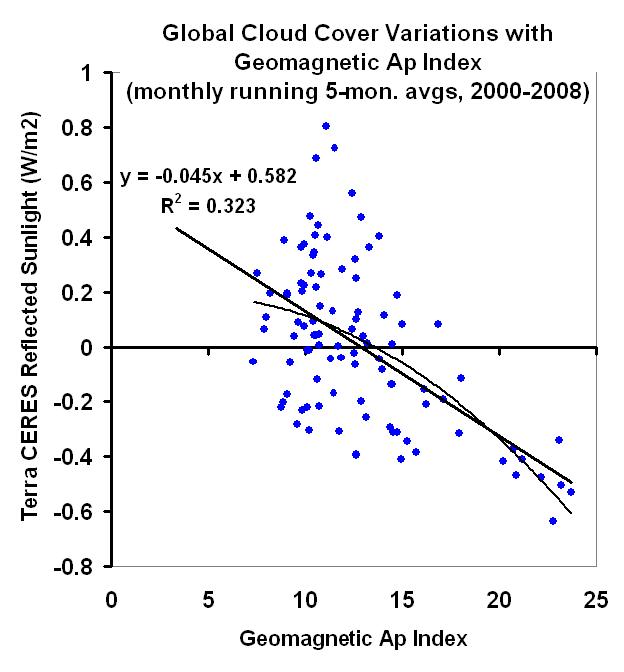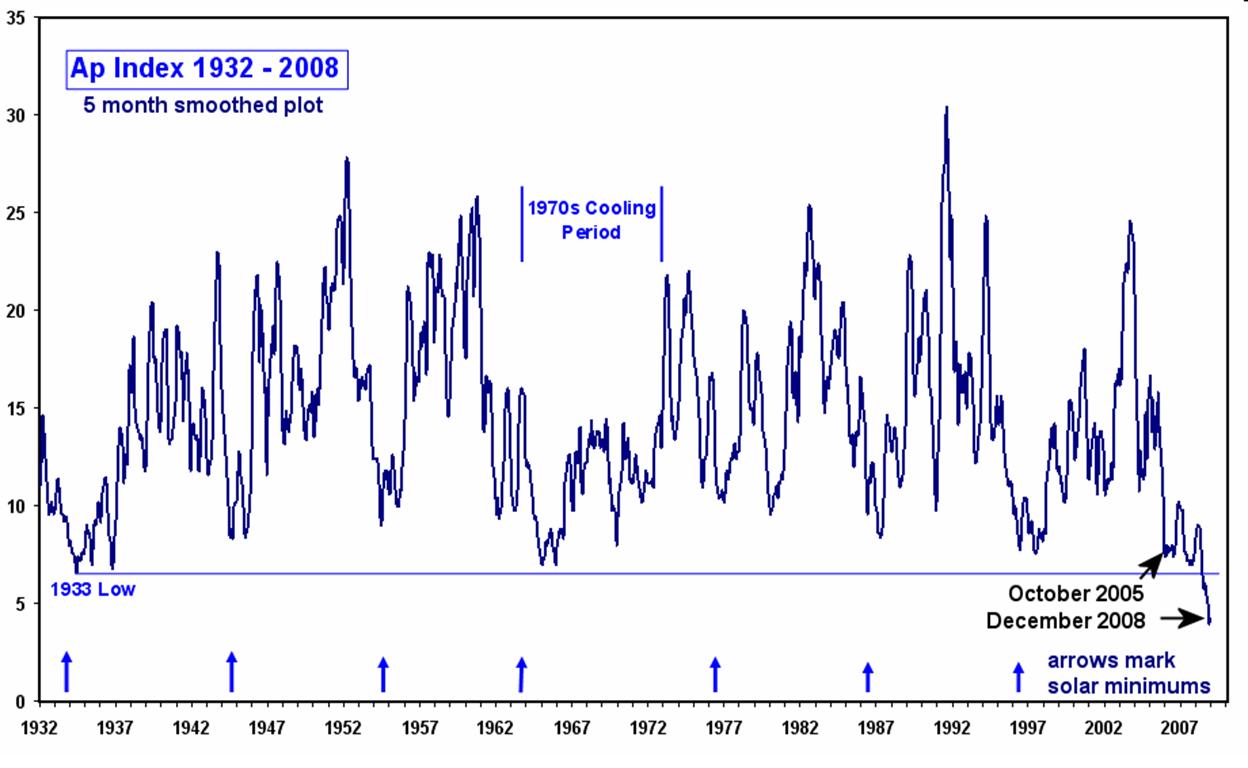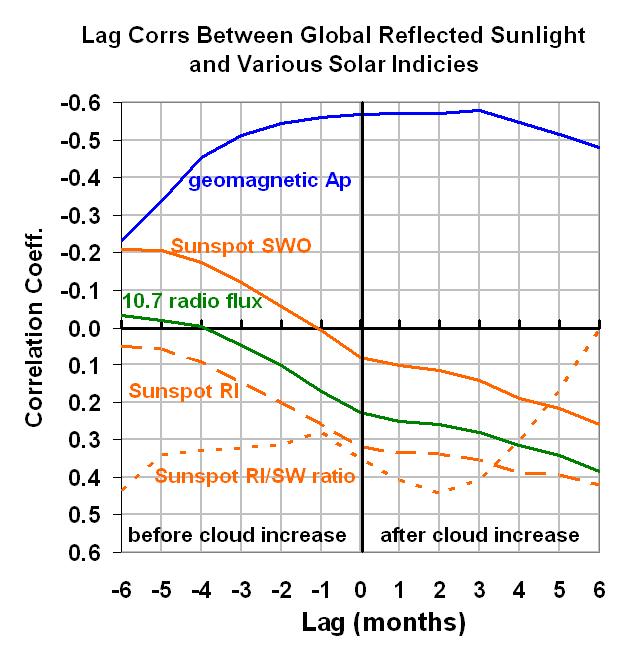I’ll admit to being a skeptic when it comes to other skeptics’ opinions on the potential effects of sunspot activity on climate. Oh, it’s all very possible I suppose, but I’ve always said I’ll start believing it when someone shows a quantitative connection between variations in global cloud cover (not temperature) and geomagnetic activity.
Maybe my skepticism is because I never took astronomy in college (oops…my wife reminds me I took it 1st year). Or, maybe it’s because I can’t see or feel cosmic rays. They sound kind of New Age to me. After all, I can see sunlight, and I can feel infrared radiation…but cosmic rays? Some might say, “Well, Roy, you work with satellite microwave data, and you can‘t see or feel those either!” True, but I DO have a microwave oven in my kitchen…where’s your cosmic ray oven?
Now…where was I? Oh, yeah. So, since I’ve been working with 9 years of global reflected sunlight data from the CERES instrument flying on NASA’s Terra satellite, last night I decided to take a look at some data for myself.
The results, I will admit, are at least a little intriguing.
The following plots show detrended time series of monthly running 5-month averages of (top) CERES reflected shortwave deviations from the average seasonal cycle, and (bottom) monthly running geomagnetic Ap index values from the NOAA Space Weather Prediction Center. As I understand it, the Ap index is believed to be related to the level of cosmic ray activity reaching the Earth. (I will address the reason for detrending below).

Note that there is some similarity between the two plots. If we do a scatterplot of the data (below), we get an average linear relationship of about 0.05 W per sq. meter increase in reflected sunlight per 1 unit decrease in Ap index. This is at least qualitatively consistent with a decrease in solar activity corresponding to an increase in cloud cover.
 (I’ve also shown a 2nd order polynomial fit (curved line) in the above plot for those who think they see a nonlinear relationship there.)
(I’ve also shown a 2nd order polynomial fit (curved line) in the above plot for those who think they see a nonlinear relationship there.)
But just how big is this linear relationship seen in the above scatterplot? From looking at a 70-year plot of Ap data (originally from David Archibald), we see that the 11-year sunspot cycle modulates the Ap index by at least 10 units. Also, there are fairly routine variations on monthly and seasonal time scales of about 10 Ap units, too (click on image to see full-size):

When the 10 Ap unit variations are multiplied by the 0.05 scale factor, it suggests about a 0.5 W per sq. meter modulation of global reflected sunlight during the 11 year solar cycle (as well as in monthly and yearly variations of geomagnetic activity). I calculate that this is a factor of 10 greater than the change in reflected sunlight that results from the 0.1% modulation of the total solar irradiance during the solar cycle.
At face value, that would mean the geomagnetic modulation of cloudiness has about 10 times the effect on the amount of sunlight absorbed by the Earth as does the solar cycle’s direct modulation of the sun’s output. It also rivals the level of forcing due to anthropogenic greenhouse gas emissions, but with way more variability from year to year and decade to decade. (Can anyone say, “natural climate variability”?)
Now, returning to the detrending of the data. The trend relationship between CERES reflected sunlight and the Ap index is of the opposite sign to that seen above. This suggests that the trend in geomagnetic activity during 2000-2008 can not explain the trend in global reflected sunlight over the same period of time. However, the ratio of the trends is very small: +0.004 Watts per sq. meter per unit Ap index, rather than -0.045. So, one can always claim that some other natural change in cloud cover is overpowering the geomagnetic modulation of cloudiness. With all kinds of climate forcings all mingled in together, it would be reasonable to expect a certain signal to emerge more clearly during some periods, and less clearly during other periods.
I also did lag correlation plots of the data (not shown), and there is no obvious lag in the correlation relationship.
All of this, of course, assumes that the observed relationship during 2000-2008 is not just by chance. There is considerable autocorrelation in the reflected sunlight and geomagnetic data, which I have made even worse by computing monthly running 5-month averages (the correlation strengths increased with averaging time). So, there are relatively few degrees of freedom in the data collected during 2000-2008, which increases the probability of getting a spurious relationship just by chance.
All of the above was done in a few hours, so it is far from definitive. But it IS enough for me to keep an open mind on the subject of solar activity affecting climate variations. As usual, I’m just poking around in the data and trying to learn something…while also stirring up some discussion (to be enjoyed on other blogs) along the way.
UPDATE (12:30 p.m. 10 December 2009)
There is a question on how other solar indices compare to the CERES reflected sunlight measurements. The following lag correlation chart shows a few of them. I’m open to suggestions on what any of it might mean.


 Home/Blog
Home/Blog



